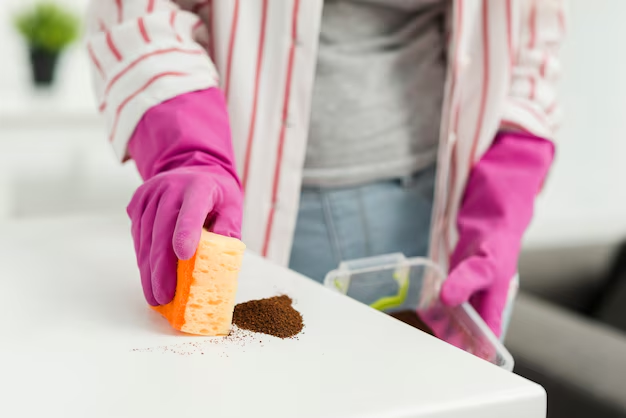Restoring Your Fridge's Surface: How to Banish Unsightly Scratches
Is your refrigerator marred by scratches that make it look aged and worn? These blemishes, though small, can detract from the overall appearance of your kitchen. Fortunately, you don't have to live with them or replace your fridge to enjoy a pristine finish again. Dive into the following guide to discover practical, effective methods for removing scratches from your refrigerator, restoring its charm and elegance.
Understanding Your Refrigerator’s Finish
Before jumping into solutions, it's crucial to identify your fridge's finish. Different materials require different care to prevent further damage.
Common Refrigerator Finishes
- Stainless Steel: Renowned for its sleek and modern look, stainless steel is a popular choice that requires careful handling.
- Painted Metal: Often found in various colors, it provides a smooth surface that may be easier to repair.
- Textured Velour and Faux Finishes: These surfaces are less prone to visible scratches, but they demand special attention.
Knowing your finish will guide you in selecting the right method to remove scratches.
Tools and Supplies: What You Need
While the tools and products necessary for removing scratches may vary slightly depending on the finish, the basics include:
- Microfiber Cloths: Essential for cleaning and polishing without adding new scratches.
- Scratch Removal Kit: Available at many stores, typically including polishes and sanding pads.
- Non-Abrasive Cleaners: Gentle cleaners won't damage the fridge's surface.
- Metal Polish or Stainless Steel Cleaner: Ideal for stainless steel fridges.
- Touch-Up Paint: Useful for painted metal surfaces.
- Sandpaper (Fine Grit): Occasionally required for deeper scratches.
Methods to Remove Scratches
1. For Stainless Steel Finishes
Stainless steel is particularly susceptible to scratches, but with the right approach, you can diminish their appearance.
Mild Scratches
Use a Stainless Steel Cleaner: Begin by cleaning the surface with a non-abrasive cleaner or a substance specifically designed for stainless steel. Apply using a microfiber cloth, moving in the direction of the grain.
Buff with a Polishing Solution: Employ a polishing solution designed for stainless steel. Apply with a microfiber cloth, gently buffing until the scratch fades.
Deeper Scratches
Sand It Out: For more prominent scratches, lightly sand the area with fine-grit sandpaper, following the grain's direction. Be gentle to avoid creating new scratches.
Polish and Clean: After sanding, apply a metal polish to restore the sheen and finish with a stainless steel cleaner to remove residue.
2. For Painted Metal Finishes
Painted surfaces offer more forgiving options when dealing with scratches.
Shallow Scratches
- Rubbing Compound: Apply a rubbing compound with a microfiber cloth, softly buffing the affected area until the scratch lessens or disappears.
Deep Scratches and Chips
- Touch-Up Paint: Use matching touch-up paint to cover deeper scratches or chips. Allow it to dry completely before applying a protective clear coat.
3. For Textured and Faux Finishes
These surfaces can be tricky, so it's essential to be cautious to avoid additional damage.
Use a Soft Cloth: Gently clean the area with a soft, damp cloth to remove any debris.
Apply a Specialized Pen or Paste: Utilize products intended for textured finishes. These can effectively camouflage scratches and restore uniformity to the surface.
Preventing Future Scratches
Prevention is the best strategy for maintaining your fridge’s condition. Here are some practical tips:
- Use Appropriate Cleaning Cloths: Always use soft, microfiber cloths for cleaning.
- Place Appliances and Utensils Carefully: Ensure sharp or metal objects don't come into contact with the fridge surface.
- Regular Maintenance: Clean your refrigerator regularly with suitable products to maintain its finish and integrity.
Pros and Cons of DIY Scratch Removal
Embarking on a DIY project to remove scratches from your refrigerator has its advantages and potential drawbacks.
Advantages
- Cost-Effective: DIY methods are generally more affordable than professional repair services.
- Convenience: Repairs can be done at your pace without waiting for a technician.
- Satisfaction and Control: Handling repairs gives a sense of accomplishment and allows you to manage the process.
Potential Drawbacks
- Risk of Damage: Without proper care, you might worsen the situation.
- Time-Consuming: Some methods require multiple steps and patience to achieve desired results.
- Variable Results: The effectiveness can vary depending on the depth of scratches and chosen method.
Visual Pros and Cons Summary
| Pros 👍 | Cons 👎 |
|---|---|
| Cost-effective | Risk of worsening damage |
| Can be done at your convenience | Time-consuming |
| Offers satisfaction and autonomy | Results may vary |
When to Call a Professional
If scratches are extensive or DIY solutions don't work, consulting a professional may be necessary. Experts have access to specialized tools and knowledge, ensuring that the refrigerator's original finishing remains intact, especially with complicated surfaces like textured or faux finishes.
Conclusion: Embrace a Scratch-Free Fridge
Restoring a refrigerator marred by scratches is a task within reach for most homeowners. By selecting the right materials, tools, and methods for your fridge's finish, you can achieve impressive results and revitalize the heart of your kitchen. From stainless steel to painted metal and textured finishes, each method holds a promise of a surface that looks nearly new. Don’t forget, once scratches have been banished, consistent care and preventative measures will keep your refrigerator looking its best for the future.
